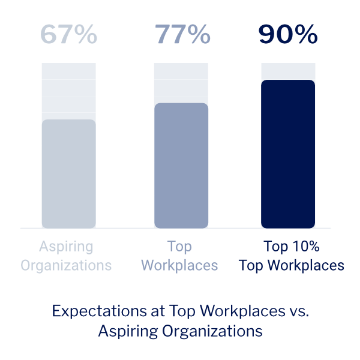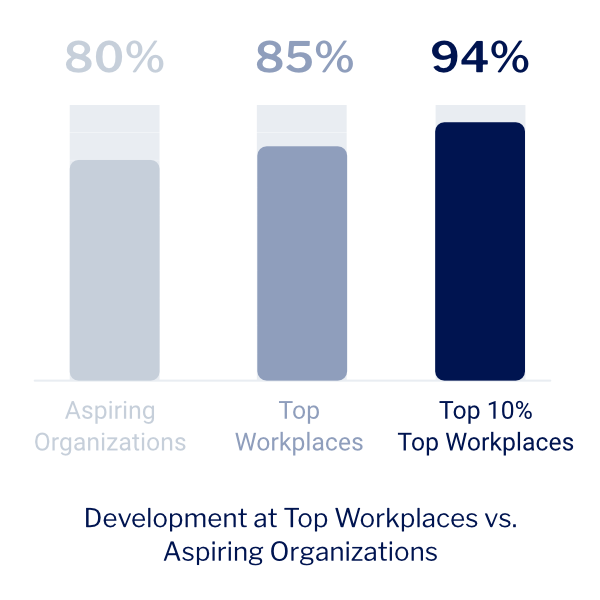From better performance and productivity to lower turnover and absenteeism, employee engagement is an outcome measure that benefits both companies and employees. And while everyone across an organization plays a role, leaders are uniquely positioned to inspire employees to do their best work or push them to disconnect and disengage.
Here we discuss how leadership influences employee engagement and share best practices that lead to the signs of engaged employees.
How leadership influences employee engagement
Great leaders know the importance of leadership and their responsibilities. Leadership impacts organizational culture in many ways, including the themes that drive employee engagement. And this is important because engagement has a significant impact on an organization’s efforts to improve employee retention and minimize employee burnout.
Let’s explore 12 best practices leadership can implement to move the needle on employee engagement — many of which are considered qualities of a good manager.
12 Leadership best practices to improve employee engagement
So, what can leaders do to improve employee engagement? These tips focus on key drivers of employee engagement identified by Top Workplaces research. Don’t be afraid to experiment with these suggestions until you find the combination that works for your unique culture.
1. Build trust
First on your leadership and employee engagement to-do list? Build trust. Engagement is about nurturing relationships, motivating employees, and celebrating progress together. Employees are more likely to trust leaders who ask, listen, and take action on feedback. Showing intentionality and transparency helps everyone feel more comfortable and confident, building trust.
2. Prioritize organizational health and well-being
Employee well-being and organizational health have become a priority for many companies. Employees are more likely to stay engaged in day-to-day activities if they are healthy and feel well. And when leaders improve employee well-being, they also prevent burnout and improve productivity. Organizational health and well-being attract new business and talent to your organization.
Learn more: How to Improve Employee Productivity
3. Show enthusiasm for your work
Passion is contagious, so genuine enthusiasm for your work and the company’s mission is essential. At Top Workplaces, we call this role modeling. Promoting enthusiasm and positivity at the leadership level creates an organizational opportunity mindset, which can help minimize manager burnout and teach employees how to turn challenging situations into growth opportunities.
4. Set clear expectations
Setting clear expectations is part of the basic employee value proposition. It begins early in the hiring process and continues throughout the employee experience. Top Workplaces excel at expectation setting:
“This job meets the expectations I had when I started.”
 Aspiring organizations are companies striving to become Top Workplaces. Those who compete generally have stronger-than-average cultures. While 67 percent of employees at aspiring organizations responded positively to the Expectations statement on the Workplace Survey, the number jumps to 77-90 percent at Top Workplaces.
Aspiring organizations are companies striving to become Top Workplaces. Those who compete generally have stronger-than-average cultures. While 67 percent of employees at aspiring organizations responded positively to the Expectations statement on the Workplace Survey, the number jumps to 77-90 percent at Top Workplaces.
5. Share goals and strategies
Empowering employees to execute is one of the culture themes that drive engagement. Employees feel well-informed when leaders share important decisions, goals, and strategies. This transparency helps teams prioritize and shows employees how they fit into your broader business strategy.
Learn more: Building Effective Teams
6. Encourage training and development
Leaders can encourage training and development by incentivizing managers to grow their employees, even if it results in team transitions. They can also equip managers with resources to support employee development. Research shows that Top Workplaces winners realize the benefits of training and development:
“My manager helps me learn and grow.”

Learn more: Improving Training and Development Strategies and Types of Employee Training and Development
7. Recognize employees and show appreciation
Top Workplaces research shows that appreciation and recognition are among the strongest drivers of employee engagement. Recognition makes employees feel appreciated, which encourages higher commitment and productivity. Showing appreciation regularly ensures employees think about their value within the organization regularly. If you haven’t already, learn more about the importance of employee recognition in your organization and explore these employee recognition ideas for more ways to celebrate.
Learn more: What is Employee Recognition?
8. Encourage workplace friendships and socialization
Encouraging friendships and socialization among employees help engagement in a few ways. Socializing makes day-to-day work more enjoyable, exciting employees to return to work. It also helps people feel more open to sharing how they feel, which helps organizations improve company culture and efficiency.
9. Keep distractions to a minimum
Inefficiency is a significant cause of poor performance for individuals, teams — and the organization. Inefficient processes and procedures are a big source of frustration for employees, especially when they have no way to address them.
An efficient organization makes good use of its investments, increasing profit with less expense. And when people feel like part of a winning team, they feel empowered to do what needs to be done to support the company’s mission.
10. Listen to employees and follow up
Keeping an open line of communication helps employees and managers feel like they can approach leaders with comments and questions. Great leadership teams know they need employee feedback to improve efficiency and performance. They also know that lack of follow-through is one of the main reasons why employees leave. Listen to your people and follow up on discussions. It’s the perfect way to get insights from those closest to the customer or product.
11. Advocate for employees
Employee engagement is all about creating a people-first culture and supporting employee needs. To do so, you need to know employee interests, values, strengths, and weaknesses. Make it clear that you understand all concerns and want to do anything necessary to make them feel their best. Adjusting roles, switching teams, and introducing new technology are great ways to advocate for your employees.
Learn more: Ethical Leadership in the Workplace
12. Ask for feedback
Nurturing the relationship between leadership and employee engagement starts and ends with communication. Ask employees how they feel about important issues and try to collect feedback whenever possible. Combining initiatives like employee engagement surveys and regular check-ins helps leaders collect information on a continuous, measured basis. Employee feedback should be a roadmap for leadership growth and development.
Gauge leadership influence with Top Workplaces
The most effective starting point for leaders to build a people-first workplace culture is measuring employee engagement with a third-party, research-backed survey. Top Workplaces is a leading award program that offers valuable employee insights and high-profile employer recognition.
Does your company prioritize employee engagement and a people-driven culture? Get recognized for it! Nominate your organization for Top Workplaces, the employee survey and employer recognition program that offers awards in 60+ regional markets and national awards for culture and industry excellence.

 Stand out with an award-winning
Stand out with an award-winning